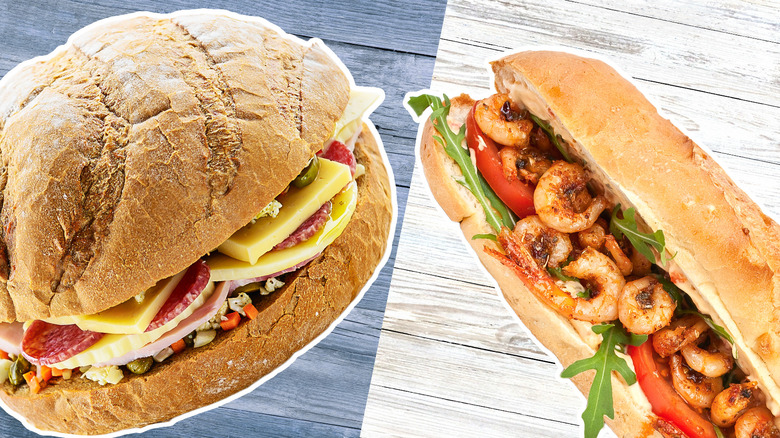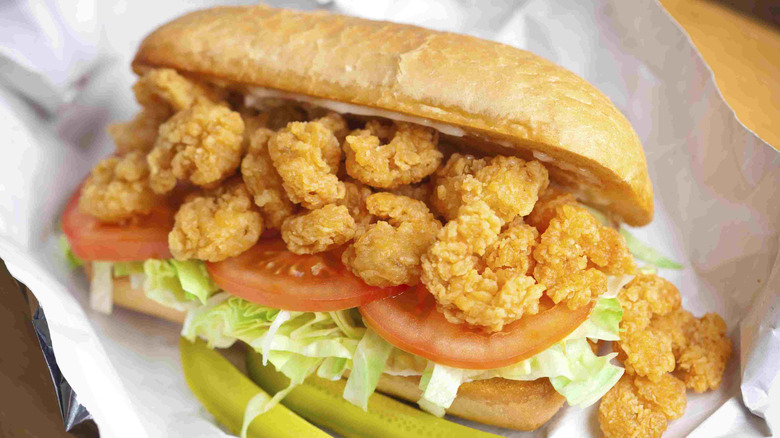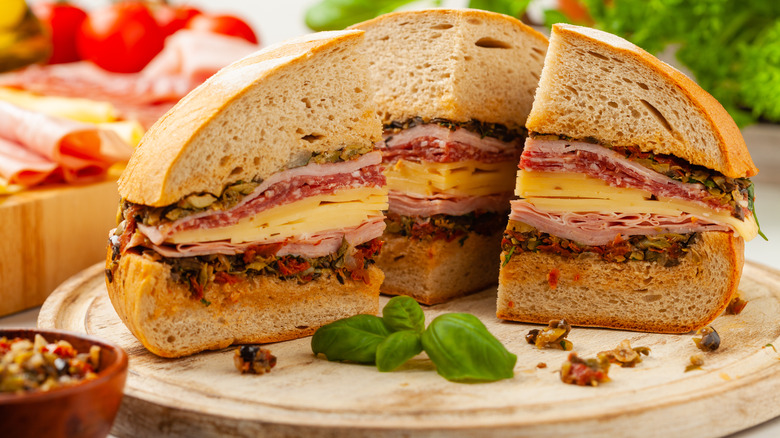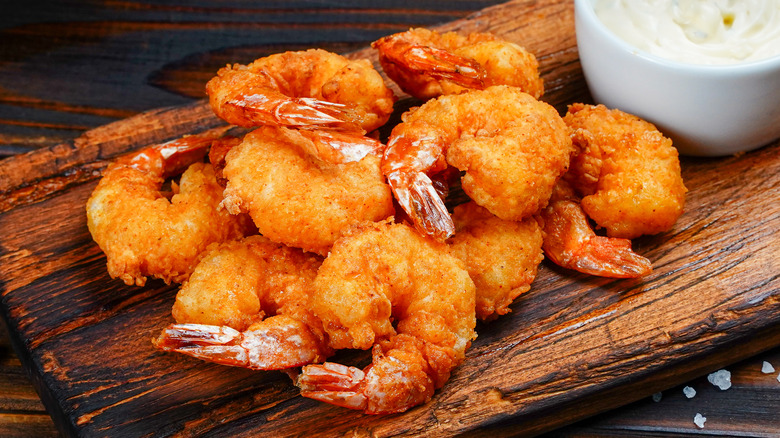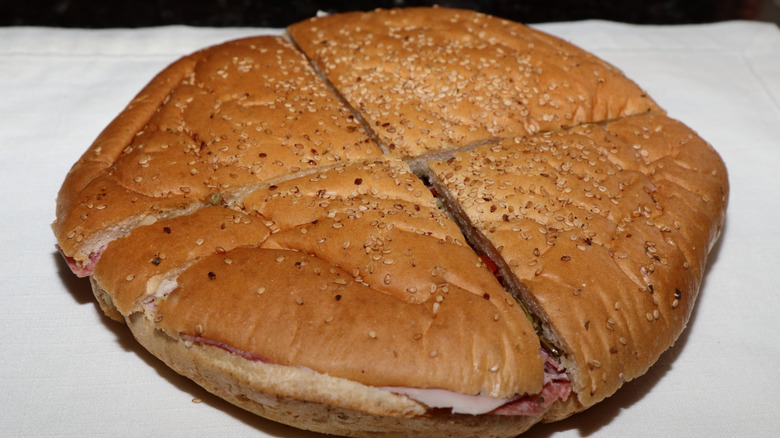Po'boy Vs Muffuletta: What's The Difference Between Sandwiches?
A visit to New Orleans can offer quite a satisfying culinary adventure for any foodie who enjoys a decadent meal. Amidst the city's lively nightlife and annual Mardi Gras celebrations are local eateries slinging famous foods like beignets, crawfish, gumbo, and jambalaya. Then there are the two delicious handheld dishes that the Big Easy is known for: Po'boys and muffuletta sandwiches, both of which you can order at an array of popular restaurants and sandwich shops across the city and around the world.
The po'boy and muffuletta are accredited to New Orleans, and they're both served on some bread like any other sandwich — but that's basically where the similarities end. Most po'boys consist of fried shrimp on a crusty hoagie-style bread although there are variations. Meanwhile, muffuletta sandwiches are made of sliced Italian cold cuts and cheese piled high onto a flat, sesame-crusted bread that the sandwich is named after.
What is a po'boy?
Most credit the creation of po'boys to Benjamin and Clovis Martin, two brothers who opened a French cafe in the late 1920s to serve free sandwiches to streetcar workers who were on strike. It's thought that the name came from "poor boys" and the sandwich originally had leftover roast beef, potatoes, and gravy. Eventually, the sandwich was piled high with freshly fried seafood, most often shrimp and sometimes fish or oysters. You can still find po'boys made with roast beef and gravy too, like at NOLA eateries such as Short Stop and Parentons Poboys.
The fried shrimp, other seafood, or roast beef is paired with sliced tomato, shredded lettuce, pickles, and typically mayonnaise on a hoagie roll. Those fixings allow the fried shrimp or other main component to shine. Sometimes a po'boy might be served with a dash of hot sauce (like Tabasco, another item we have to thank Louisiana for) or a Cajun-style remoulade made with ingredients including ketchup, mayo, and Worcestershire sauce, instead of plain mayo. Eat a po'boy on its own or paired with potato chips.
What is a muffuletta sandwich?
This history of the muffuletta dates back to the early 1900s when Sicilian immigrant Salvatore Lupo combined classic Italian ingredients to create the sandwich. Those ingredients include cold cuts like sliced salami, ham, and mortadella with Provolone cheese and what some might consider the star of the dish: Olive salad. It's traditionally made of vegetables like cauliflower, carrots, and peppers, and pitted Kalamata olives that are all chopped up and mixed with olive oil and often red wine vinegar that works as a tangy topping to pair with the meats and cheeses. Think of it as a version of giardiniera infused with olives.
When it comes to variations of the sandwich, most recipes adhere to the classic version. There are, however, some people who prefer the sandwich hot instead of cold like Lupo served it. For a hot muffuletta, some might use Swiss cheese instead, but both varieties are solid melting cheeses to obtain that gooey texture you might expect from a hot sandwich. These sandwiches, especially the authentic version made with the sesame-crusted bread, can be quite large so it's great to slice and share with others.
A po'boy is typically made with fried seafood
With the exception of the original po'boy made with roast beef mentioned earlier, most versions rely on fried seafood such as shrimp, soft-shell crab or crab cakes, oysters, fish like catfish or tilapia, and in some cases, more exotic meats like alligator. Regardless of which protein is chosen, that meat is then dredged in seasoned flour or cornmeal and then deep-fried to crispy perfection. It's the main component of the sandwich, while the toppings like mayo, shredded lettuce, and pickles simply play a supporting role. And while you might occasionally come across a po'boy made with unbreaded shrimp, it's not authentic to the many variations.
Alternatively, muffulettas use cold cuts, preferably freshly sliced from the deli when possible — no oil or deep frying required. Of course, some Italian cold cuts like salami are cured. For the cold cuts, it's typically the same meats like thinly sliced Genoa salami, ham, and mortadella that go onto the sandwich. Do some delis and home cooks throw on an extra ingredient like pepperoni? Sure, but the sandwich doesn't allow for the wide range of meat alternatives like the po'boy often does.
A muffuletta requires a dense Italian-style bread
The type of bread that's used to make a muffuletta is essential because it's where the sandwich got its name, after all. Muffuletta is a dense, round white Italian bread that's usually about 10 inches in diameter. It's crusted with sesame seeds and is cut open to create the sandwich. It's a common technique to scoop out some of the bread inside to make room for the olive salad, cold cuts, and cheeses. If you don't have an authentic Italian bakery nearby, and your go-to grocery store doesn't sell the bread, then it might be best to make it from scratch for an authentic sandwich.
On the other hand, a po'boy traditionally uses a French baguette-style bread that's far more common to find. The sandwich is the New Orleans version of a hoagie sandwich, so any crusty oblong-shaped bread you can find will work. Some recipes suggest toasting the bun with butter, which is an important step if you prefer a warm sandwich, otherwise, you can slice the fresh bread and pile on the fried seafood and the fixin's, as they refer to the toppings down in NOLA.
